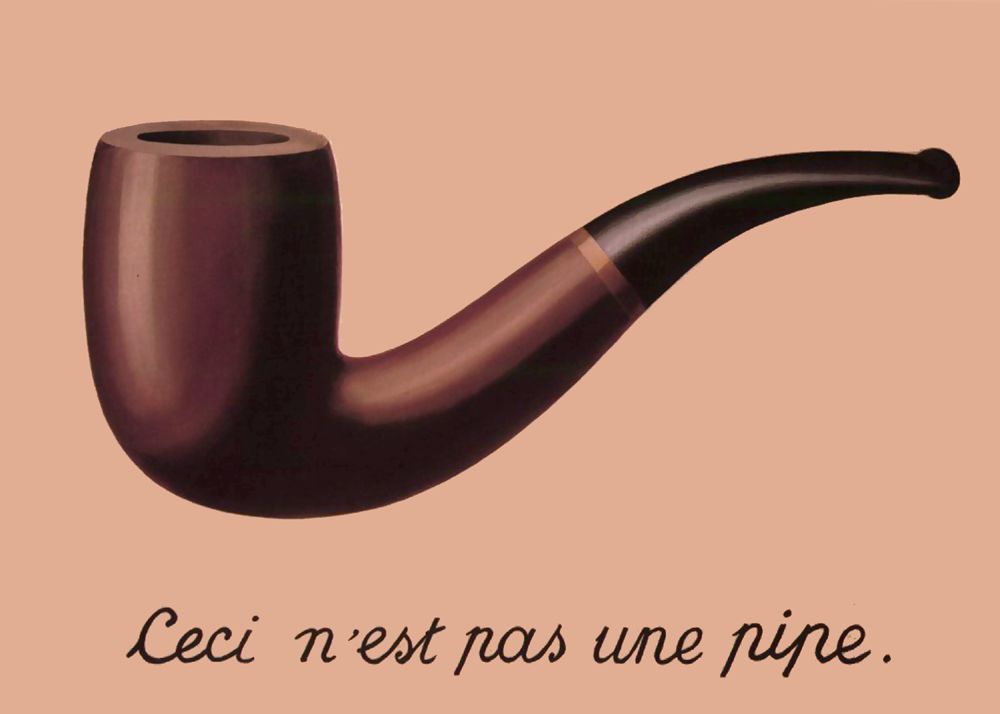Revealing the reality behind the illusion
Independent, The (London) , May 5, 1998 by John Windsor

The origins of Magritte's masterpiece of surrealism (above) have been ignored for 17 years says Silvano Levy.
THE enigma of Rene Magritte's famous painting of a pipe still puzzles the crowds that shuffle past it at the big centenary retrospective exhibition of his work in his home town, Brussels. Its secret - a private joke of Magritte's - might have died with him but for detective work by a young academic whose revelations have been passed over by art historians for 17 years.
"This is not a pipe" says the Belgian Surrealist's inscription. That's the point, intone art historians. It's only paint on canvas - Magritte's play on the way painting represents three-dimensional objects as two- dimensional illusions. But look at the pipe on the shopfront of Vinche's, the tobacconist's, in the Rue Marche Aux Herbes, in the heart of Brussels. Is it not remarkably familiar?
This is the pipe that inspired Magritte. It is, of course, only a representation of a pipe - flat, two dimensional. Ceci n'est pas une pipe. "No," Magritte must have chuckled to himself, "and it never was."
A tall story? Back in 1980, Silvano Levy, now senior lecturer in French at Keele University, was researching a PhD thesis on Magritte. He spotted a photograph of Vinche's shopfront in a book on Twenties window dressing. "Suddenly, Magritte's pipe flashed in front of my eyes. The photograph had been taken in 1927, the year before Magritte painted his pipe. It was dominant, overwhelming in size. Just like the pipe in the painting."
A descendant of Vinche, located through the Brussels telephone directory, supplied Levy with the original photograph of the shopfront, as it then was, but had no tales to tell about Magritte. Nevertheless, the photograph showed not only the giant pipe screwed to the second-floor facade, but two pairs of pipes in stained glass in the shop window that were the exact shape and pose of a pair of pipes that Magritte had drawn, joined at the mouthpiece.
"That clinched it for me", he said. "I realised I had found the source of one of the most famous images of the 20th century." But he still lacked first-hand evidence that Magritte had ever clapped eyes on Vinche's pipes.
Soon afterwards, he found himself taking tea and petits fours in the comfortable Brussels sitting room of Magritte's late widow, Georgette, then nearly 80. Instantly recognisable as the artist's model - poised, polite and still beautiful - she sat at the piano and played him airs by Satie, just as she had for Rene. But she had never heard him talk about the origins of the pipe.
"Yes," she said, "he would have known of the shop". But then, so did everyone else in Brussels. It was Louis Scutenaire, who worked with Magritte, who firmed up the connection. "Yes," he told Levy, "Magritte knew the shop and walked past it practically every week."
Like Georgette's house, Scutenaire's was encrusted with paintings by Magritte. There were even Magrittes hanging over the bath. "What would happen if they fell in?" Levy asked him. "Then they would get wet," was the reply.
Levy had, of course, already visited the shop. He found it selling not pipes, but electronic calculators. "I took photographs," he said: "They must have thought I was some sort of maniac or industrial spy." They knew nothing of Magritte.
Levy published his findings in a paper, "Rene Magritte and Window Display" in Artscribe No 28 of March 1981. Since then, the paper has been occasionally cited in standard works on Magritte, but the discovery of the original pipe has not got a mention. A pity, thinks Levy.
"The significance of discovering that Magritte's pipe originates from a 2D image is that, in reality, in the world in which we live and breathe, the 2D world exists in its own right. It's a major additional step in the interpretation of Magritte's painting that academics and writers have not fully appreciated."
Is anything left of Vinche's pipe? Gazing upwards to where it had been screwed to the shop's marble cladding, Levy could discern its shape. The marble was paler where the pipe had protected it from the weather. Not a pipe. Not even a representation of a pipe. Just a virtual reality. But a reality all the same.